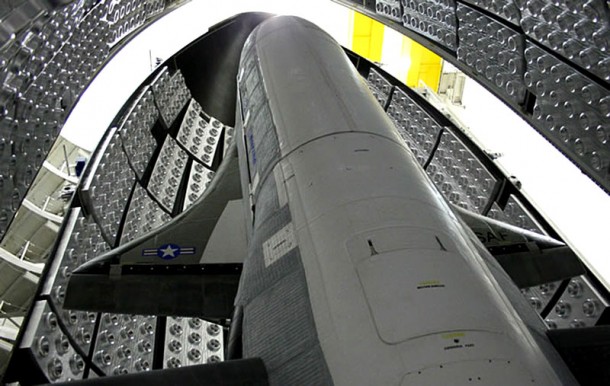Last month's launch of the US Air Force X-37B secret mini space plane has fueled speculation about the real mission of this vehicle and if it could possibly be used for a new type of military weapon. The X-37B launched on April 22, 2010 and has the ability to stay in orbit for up to 270 days.
While the Air Force provided a webcast of the launch, since then there has been no word — leaked or official – about the status of the mission. "There has been a lot of speculation about what this vehicle could do and what sort of capabilities it could provide to the U.S. military, and some of that speculation was based on more science fiction than fact," said Brian Weeden from the Secure World Foundation. "While a successful completion of the X-37B flight, landing, and turn-around will certainly be a significant step forward in reusable space vehicle technology, it is a long ways away from a single-stage-to-orbit capability."
Weeden has put together a fact sheet on the X-37B, looking at the technical feasibility of some of the proposed missions for the mini space shuttle look-alike, and says the there's almost no chance it could be used as a new weapon or a new weapon delivery system.
The X-37B will land unpiloted at Edwards Air Force Base in California. It uses solar arrays and lithium ion batteries to generate power instead of fuel cells like the space shuttle, a major reason why it can stay on orbit for much longer.
Weeden said that after looking at all the proposed missions for the X-37B, he concluded the most likely is probability is that it will be used as a flexible, responsive spacecraft to collect intelligence from space and as a platform to flight test new sensors and satellite hardware.
"One of the downsides to using satellites for collecting intelligence is that once they are launched they have a fixed set of sensors and capabilities," Weeden said. "The X-37B brings to space the capability to customize the on-board sensor package for a specific mission, similar to what can be done with U.S. reconnaissance aircraft such as the U-2 and SR-71. In many ways, this gives the X-37B the best of both worlds," he added.
Here's a brief look at the potential uses for the X-37B:
On-orbit sensor platform and test bed, with the ability to return payload. "What it offers that we have seldom had is the ability to bring back payloads and experiments to examine how well the experiments performed on-orbit," said Gary Payton, the undersecretary of the Air Force for space programs. "That's one new thing for us."
Given the R&D that likely was put into the X-37B, this approach probably isn't very cost-effective, but Weeden said this is the most likely use the spaceplane. X-37B payload bay could hold various sensors used for intelligence collection of the Earth from space, potentially including radar, optical, infrared, and signals/electronic intelligence suites to flight-test and evaluate new sensors and hardware.
Deployment platform for operationally responsive space satellites. Weeden said this has a midrange chance of being X-37B's mission, and he quotes Payton: "We could have an X-37 sitting at Vandenberg or at the Cape, and on comparatively short notice, depending on warfighter requirements, we could put a specific payload into the payload bay, launch it up on an Atlas or Delta, and then have it stay in orbit, do the job for the combatant commander, and come back home. And then the next flight, we could have a different payload inside, maybe even for a different combatant commander."
But given it still would be dependent on the availability of EELV, it may not have a very quick response time for launch.
On-orbit repair vehicle. Weeden said this option has a fairly low chance of being X-37B's real mission. While it could be used to rendezvous with malfunctioning satellites and repair or refuel them, the X-37B is limited in altitude (it has been rumored that it will have a maximum altitude range of 700 or 800 km (about 500 nautical miles), potentially high enough to access most Sun-synchronous satellites, but this is unconfirmed, plus not many existing operational military satellite components will fit in the X-37B cargo bay. And as the engineers who tried to figure out how to fix the Hubble Space Telescope robotically, without humans, on-orbit repair is extremely difficult, if not impossible.
On-orbit inspection of satellites. This option has a low potential, as well. The X-37B could be used to rendezvous and inspect satellites, either friendly or adversary, and potentially grab and de-orbit satellites. However, the X-37B cargo bay is much smaller than many operational satellites, and most of the space in the bay is likely to be filled by the required robotic arm and other gear.
Conventional Prompt Global Strike (CPGS) weapon or delivery system. Weedend says that chance of this being X-37B's mission is zero. It could be launched in response to a pending crisis and remain on orbit for a length of time to respond to high value/very time sensitive targets. However, since the X-37B re-enters like the space shuttle and lands at an estimated 200 mph (321 kph), this means it travels in the atmosphere much slower than a ballistic arc or a hyperkinetic weapon, so it would need to carry conventional explosives to do any significant damage. Also, after re-entry would be a slow moving, not-very-maneuverable glide bomb, easy prey for any air defense system along its path to the target.
Written by Nancy Atkinson and published by Matt on Thu May 20, 2010 12:12 pm via: Universe Today








